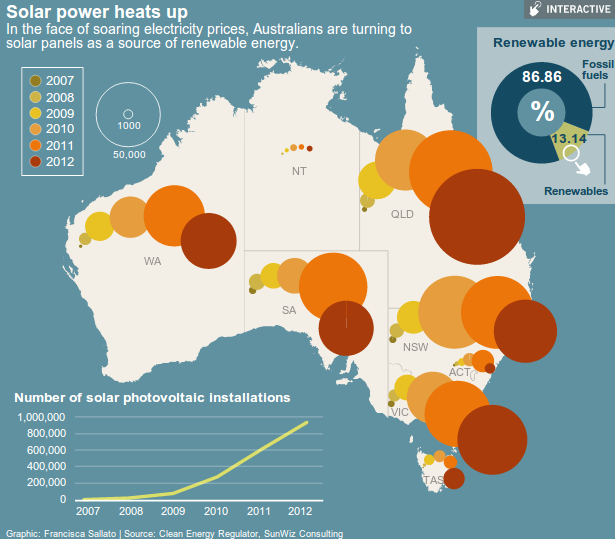Australia will vote for a new federal government on 7 September 2013–less than a week away–and although by no means a certainty, polls show the Lib-Nats tipped to win, ushering in the end of 3 terms of Labour government. During the ALP’s time in office much legislation has been enacted or strengthened in the name of promoting uptake of renewable energy and reducing CO2 emissions. The most high-profile of these is of course the Carbon Tax, which Coalition leader Tony Abbott has sworn to repeal if elected, but a number of other climate- and renewable-related programs and government bodies established to implement them face elimination. Although the Renewable Energy Target is largely expected to remain intact, the Clean Energy Finance Corporation (CEFC) and the Climate Change Authority would be among those to get the axe. What does all this mean for renewable energy in Australia, and in particular–since this is a solar-focused website after all–what would it mean for residential, commercial-scale, and utility-scale solar photovoltaic (PV)?
Solar PV technology has come a long way in the past few years, and government policy has and still does certainly play an extremely important role in making solar energy as affordable as it has managed to become here. Although incentives have been rolled back across the board across the states and on the Federal level, they still play a vital role in the industry, and few in the Australian renewable energy industry would contest that renewables won’t take a hit with a change of government. The gist of the story is that, given the relatively low priority that clean energy support has on the Coalition’s agenda vs Labour’s, renewable energy growth will slow. It has been estimated, as pointed out by SMH, that as much as $4.1b in private investment in renewable energy would be held back over the next 3 years if the Coalition comes to power and dismantles the programs it is promising to dismantle.
At the same time, offering a ray of sunshine is the fact that there are much larger forces behind solar PV’s rise to prominence in Australia–and more importantly, its future course–than just government policy. Solar system installation prices have come down dramatically in the past few years due mainly to ramped-up manufacturing in China, making them more accessible than ever for homes & businesses across the globe. Most state-based solar feed-in tariff incentives are now closed, but thanks to their having been around solar PV systems are now firmly lodged in the minds of the populace as a way to save money, especially considering how much retail electricity prices have risen over the past few years. On top of all this, zero-down solar panel leasing deals–incredibly important in the growth of solar power in the US–are gradually making their way into the Australian market, opening doors to going solar for a larger number of homes & businesses than ever before. The infographic below (via SunWiz, SMH, and the Clean Energy Regulator) demonstrates just how solar PV installation numbers have grown in the past few years; at the time of writing, there are now well over 1 million homes with solar panels.
Image via SMH. Click to go to see original.
No matter how you look at the situation in the short term, the future seems bright for solar PV in Australia in the long-term. Interviewed in the SMH article linked above, Oliver Yates, the head of the CEFC and former Macquarie Bank executive, gives weight to the belief in what Nigel Morris termed the inevitability of solar PV. “What we are seeing is a transition from a high-carbon to a low-carbon system,” Mr Yates says, but cautions on the importance of government’s role in ensuring that the transition is a smooth one: “What we’re heading into is a period of sustained high volatility in the industry. There is a high possibility that, if this is not managed correctly, we will all end up with much higher costs than we could have had. … You can transform the energy system in a non-disruptive fashion or in a disruptive fashion … But ultimately it is going to be transformed.”
He likens renewable energy systems such as solar panels and wind power to a ‘robot on the pitch’. Solar panels and wind turbines will go on producing power whenever the sun is shining or wind blowing. Unlike coal or gas-fired power plants, they don’t require fuel and are essentially free to run. The problem is that no one can summon the wind or sun at will, and this is when the conventional players need to be brought online, despite their vulnerability to fuel price fluctuations. More homes & businesses opting to generate their own power with solar panels, for example–not to mention larger developments in the commercial and utility-scale spheres–will put increasing pressure on conventional means of power generation. ”At the end of the day, if your competitor is doing the same job for less, it’s a problem for you. Increasingly, we will see this taking effect on the profitability of the traditional players.”
© 2013 Solar Choice Pty Ltd
- Solar Power Wagga Wagga, NSW – Compare outputs, returns and installers - 13 March, 2025
- Monocrystalline vs Polycrystalline Solar Panels: Busting Myths - 11 November, 2024
- Solar Hot Water System: Everything You Need to Know - 27 February, 2024
